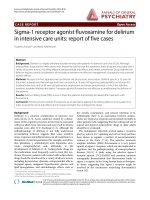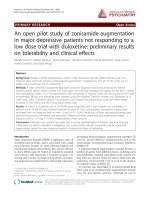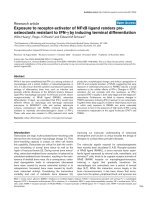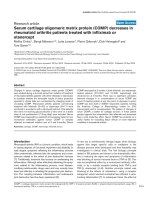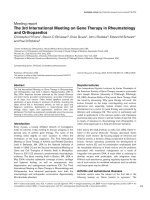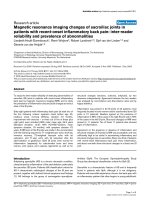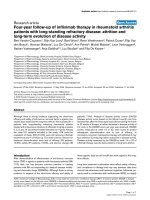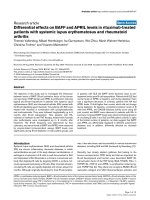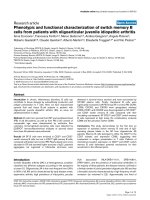Báo cáo y học: "Procalcitonin to guide duration of antibiotic therapy in intensive care patients: some research questions" pptx
Bạn đang xem bản rút gọn của tài liệu. Xem và tải ngay bản đầy đủ của tài liệu tại đây (38.39 KB, 2 trang )
Available online />Page 1 of 2
(page number not for citation purposes)
The article by Hochreiter and colleagues on the use of
procalcitonin to guide duration of antibiotic therapy in
intensive care patients is timely and significant, but it raises a
number of unresolved issues [1].
First, it was entirely appropriate that the physician in charge
of the surgical intensive care ward had the option to proceed
with or to adjust the antibiotic treatment if there were clinical
reasons to do so. Whether such adjustments were made
either in the control group or in the procalcitonin-guided
antibiotic therapy group, however, is not clear.
Second, Table 1 in their article indicates a longer number of
days in intensive care for those patients in the control group
than for those undergoing procalcitonin-guided antibiotic
therapy [1]. Since 36% of the patients in each group did not
survive, however, the length of stay in intensive care for both
groups may be confounded by death.
Finally, again in Table 1 [1], were there differences in out-
come for those patients diagnosed with pneumonia and
those diagnosed with peritonitis in either the control group or
the procalcitonin-guided antibiotic therapy group?
Despite more than 10 years of research into the usefulness of
procalcitonin therapy, Hausfater is right to point out that ‘its
exact place in the diagnostic process remains to be defined’
[2]. Both the articles of McLean and of Christ-Crain and Müller
have proposed further study of alternative novel biomarkers
[3,4]. Early diagnosis of sepsis linked to timely but limited use
of antibiotics remains paramount, whichever biomarkers make
it possible to save more patients’ lives in intensive care.
Letter
Procalcitonin to guide duration of antibiotic therapy in intensive
care patients: some research questions
Robert E Kahn
Avian Flu Action, 40 St Stephen Road, Great Sankey, Warrington WA5 2BJ, UK
Corresponding author: Robert E Kahn,
Published: 30 July 2009 Critical Care 2009, 13:414 (doi:10.1186/cc7958)
This article is online at />© 2009 BioMed Central Ltd
See related research by Hochreiter et al., />Author’s response
Stefan Schroeder
Included in our investigation were surgical intensive care
patients who were receiving antibiotic therapy for confirmed
or suspected high-grade bacterial infections. Irrespective of
the study arm and at any time point, the physician in charge
had the option to proceed with or to adjust the antibiotic
treatment, if there were clinical reasons to do so [1].
Beyond a reduction in the length of antibiotic treatment,
procalcitonin guidance also had a favourable effect on the
length of the intensive care stay – a stay 2 days shorter, on
average, compared with control individuals. This result may
possibly be influenced by increased vigilance and continuous
monitoring of patients with shortened duration of antibiotic
therapy. Our results, however, showed that the clinical
outcomes of the procalcitonin group were at least as good as
those of the control group since the survival rate of 73.6% was
comparable in both groups. These findings are in accordance
with a recent publication [5]. We therefore do not believe that
the length of stay in intensive care was biased by the mortality
rate in our study. Both treatment groups were comparable in
terms of diagnoses and disease severity. In addition, we found
no significant differences in outcome for those patients
diagnosed with pneumonia and those patients diagnosed with
peritonitis, on comparing the treatment groups.
Monitoring procalcitonin is a valuable tool for therapeutic
decision-making concerning the length of antibiotic treatment.
Adequate interpretation of procalcitonin concentrations,
however, always requires background information concerning
the clinical course and symptoms. Moreover, further research
is needed: Procalcitonin-guided antibiotic therapy must still
be tested in heterogeneous groups of patients, particularly for
safety. Cut-off points for antibiotic termination have to be
defined uniquely.
Critical Care Vol 13 No 4 Kahn
Page 2 of 2
(page number not for citation purposes)
Competing interests
SS has received payments from BRAHMS AG for speaking
engagements.
References
1. Hochreiter M, Köhler T, Schweiger AM, Keck FS, Bein B, von
Spiegel T, Schroeder S: Procalcitonin to guide duration of
antibiotic therapy in intensive care patients: a randomized
prospective controlled trial. Crit Care 2009, 13:R83.
2. Hausfater P: Procalcitonin measurement in adult clinical prac-
tice [in French]. Rev Med Interne 2007, 28:296-305.
3. McLean A: Procalcitonin: seeking a niche. Crit Care 2009, 13:
149.
4. Christ-Crain M, Müller B: Procalcitonin and pneumonia: is it a
useful marker? Curr Infect Dis Rep 2007, 9:233-240.
5. Nobre V, Harbarth S, Graf JD, Rohner P, Pugin J: Use of procal-
citonin to shorten antibiotic treatment duration in septic
patients. A randomized trial. Am J Respir Crit Care Med 2008,
177:498-505.

